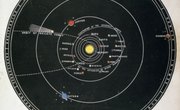
Rotating around a central sun are eight planets, which -- along with dwarf planets, moons, asteroids and comets -- comprise this solar system. Whether terrestrial or gaseous, each planet has unique characteristics that differentiate it from the rest. One major variation among these eight bodies is size, having a vast range in circumference from smallest to largest.
Mercury
Mercury is the smallest planet in the solar system. Its circumference is merely 9,522 miles, and its area totals 28,873,225 square miles. It is a terrestrial planet with a surface covered in craters, and its close proximity to the sun sometimes results in surface temperatures as high as 800 degrees Fahrenheit. Its lack of heat-retaining atmosphere, though, can cause nighttime temperatures nearing 300 degrees Fahrenheit. Besides its faint, occasional twilight appearances, Mercury is indirectly visible from Earth about a dozen times per century as it passes across the sun.
Venus
Venus is similar to Earth in size, with a circumference of 23,617 miles and an area of 177,628,840 square miles. Venus’ atmosphere contains clouds of sulfuric acid, which reflect sunlight, allowing Venus to appear brighter than other planets from Earth. Its atmosphere traps heat and can cause surface temperatures of almost 900 degrees Fahrenheit; this sweltering heat has destroyed all probes that have landed on the planet. Over a thousand volcanoes are strewn across Venus’ surface.
Earth
The third planet from the sun is Earth, the only planet known to contain life. Its circumference is just greater than that of Venus at 24,889 miles. Of its total area -- 197,280,733 square miles -- 70 percent is covered by oceans. It orbits the sun at a distance of nearly 93 million miles on a tilted axis of over 23 degrees, creating four distinct seasons. Earth’s uniquely thin, but powerful atmosphere alters both climate and weather, protects inhabitants from the sun’s radiation and acts as a shield for meteors.
Mars
Having a circumference of 13,256 miles and an area of 55,963,741 square miles, Mars is the second smallest planet in the solar system. This terrestrial planet, known as the “Red Planet” due to its color of soil, has some notable geological features including tremendous volcanoes and a canyon system that stretches the width of the United States. Though its temperatures are too low for liquid water to remain on its surface, Mars has polar ice caps that expand and shrink according to the shift in seasons.
Jupiter
The largest planet in the solar system -- with a circumference of 278,985 miles and an area of 24,787,374,965 square miles -- is Jupiter. This gas giant is the fifth from sun and has 63 moons of its own, four of them the size of planets. Its unusual coloring is a product of visible ammonia clouds and stripes formed by east-west winds creating dark belts and light zones. These “stripes” are full of storm systems that have endured for many years, including the spinning storm known as the Great Red Spot, which is over 300 years old.
Saturn
At 235,185 miles in circumference and 17,615,265,865 square miles in area, Saturn is the sixth planet from the sun and the second largest gas giant. Its composition is mostly hydrogen and helium, while its famous rings are deceptively complex: primarily made of water ice, some braided or spoked in appearance. Saturn’s own banded appearance is the result of gusts in the upper atmosphere many times the speed of hurricane winds. Saturn has 52 known moons, two of which orbit within its rings.
Uranus
Uranus, the seventh planet from the sun, is another gas giant. It measures 99,739 miles in circumference and 3,168,132,663 square miles in area. Its blue-green appearance is a result of methane gas in its atmosphere. It rotates on a nearly horizontal axis, perhaps due to a collision with another planetary body far in the past, but the resulting seasons are not very distinct due to its distance from the sun. Uranus has 11 rings -- which are uniquely perpendicular to its orbit -- and 27 known moons.
Neptune
Nearly three million miles from the sun, Neptune -- measuring 96,645 in circumference and 2,974,591,827 square feet in area -- takes over 150 years to complete its orbit. It cannot be seen by the naked eye from Earth, despite its intense blue color, a product of atmospheric methane. Among Neptune’s distinguishing features are winds many times the strength of Earth’s, 13 known moons, six rings and a raging hurricanelike storm known as the Great Dark Spot large enough to encompass the Earth.
About the Author
Alyssa Brode began writing in 2001. She served as a staff writer for her high school newspaper, "The Arrowhead," and has been freelancing ever since. She has a Bachelor of Music degree from Westminster Choir College of Rider University with a double major in voice performance and computer information systems and is pursuing a Master of Music in opera performance.
